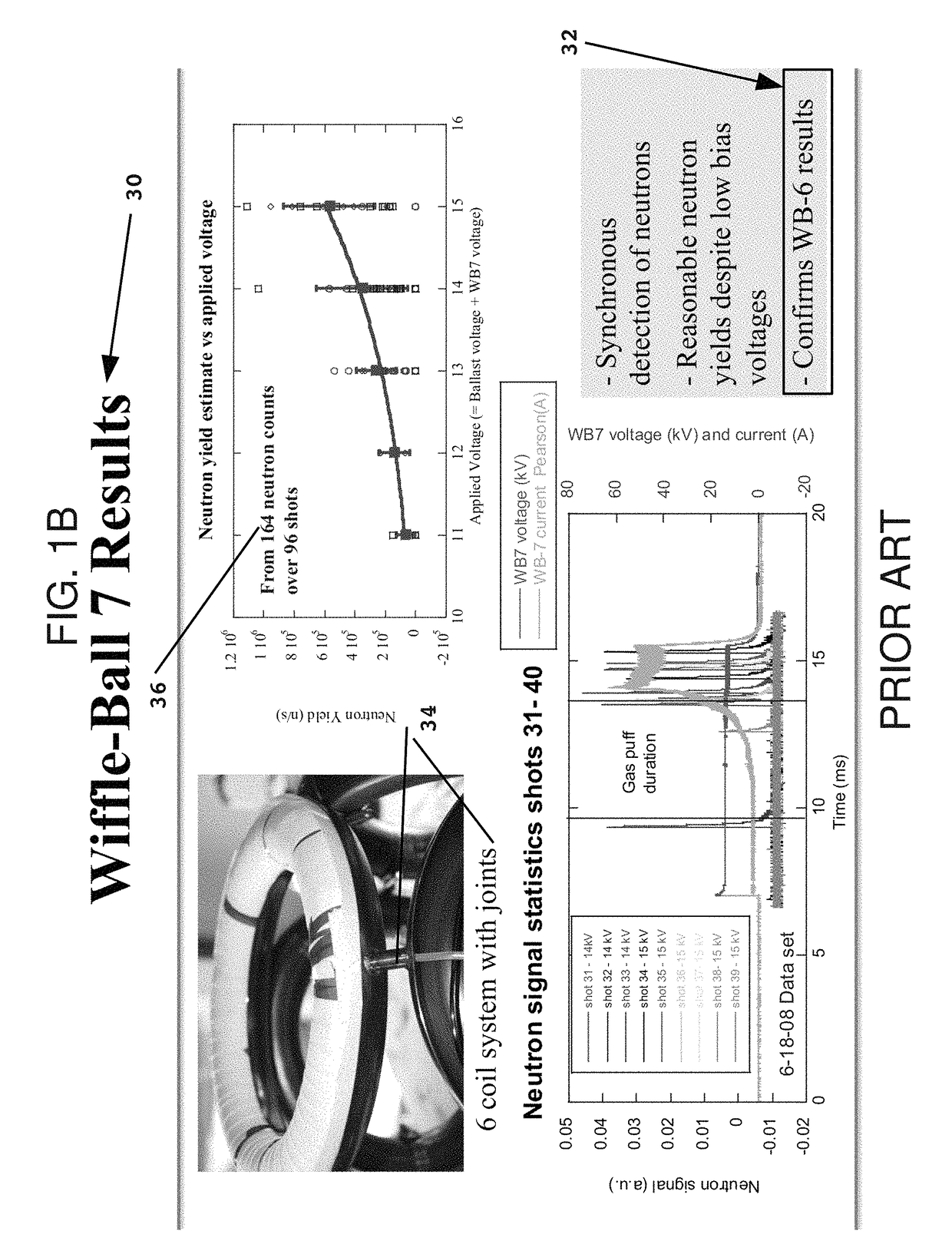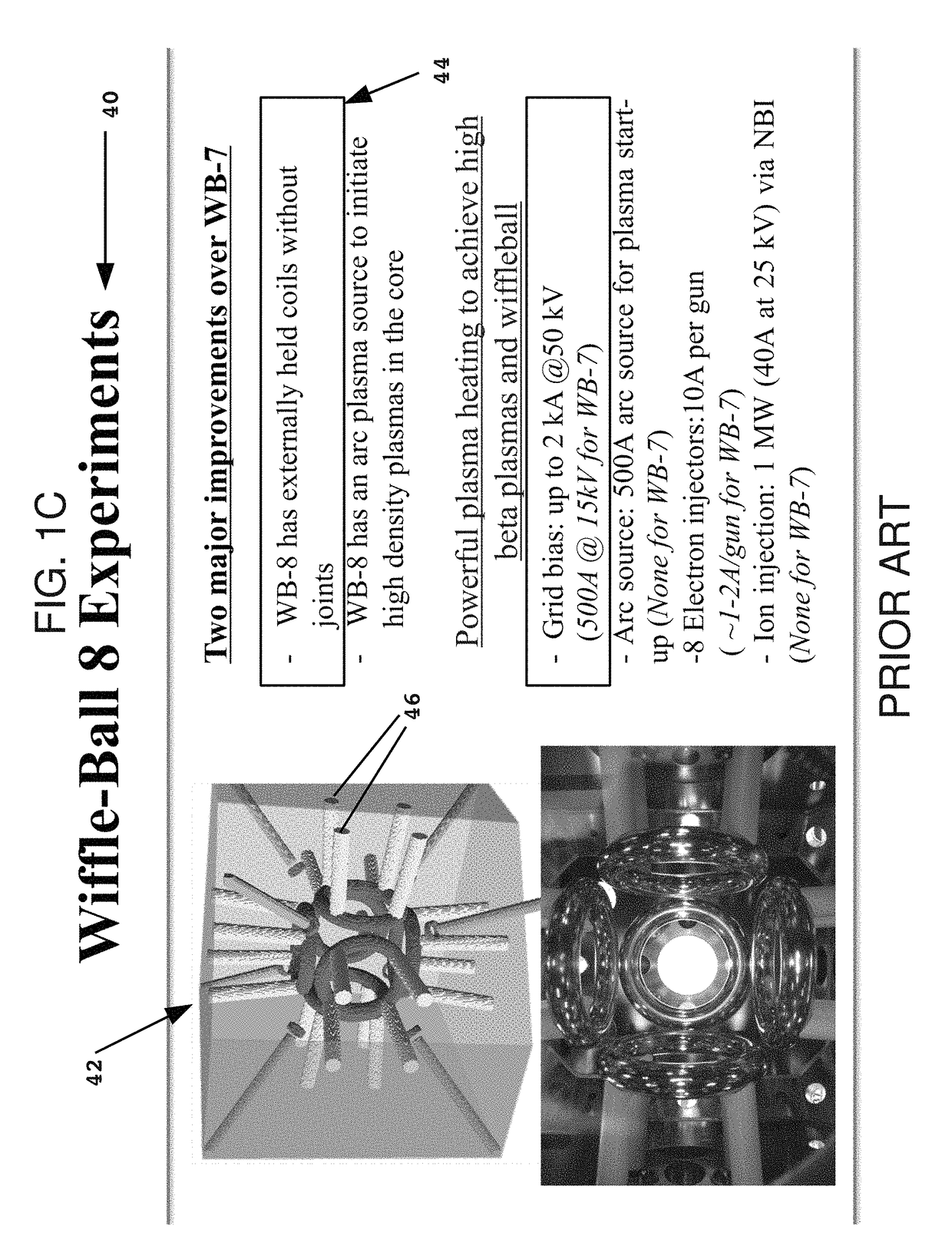Apparatus and method for controlling a plasma fusion reactor
a plasma fusion reactor and apparatus technology, applied in nuclear reactors, climate sustainability, nuclear energy generation, etc., can solve the problems of inability to meet the requirements of the specification, the diamagnetic field growth rate was so slow, and the simulation time on the computer ran out before the diamagnetic field became significant,
- Summary
- Abstract
- Description
- Claims
- Application Information
AI Technical Summary
Benefits of technology
Problems solved by technology
Method used
Image
Examples
first embodiment
Large Scale Model Made with Coil Electromagnets
[0154]In order to be useful for generating nuclear power, a Polywell reactor must produce more power than it consumes. By standard definition, the power is the volume integral of the power-density of the fusion reactions in the confined ion plasma. A familiar formula for power density is given in textbooks, for example Glasstone and Lovberg, “Controlled Thermonuclear Reactions,” published in 1960. According to eq. (2.17) of Glasstone and Lovberg, the power density of a deuterium plasma is ½ n2 Q, where n is the particle-density (ions per unit volume), is the of fusion cross-section(σ) times ion-ion relative velocity(v), and Q is the energy released by each fusing pair of deuterons. The units of power density, as calculated from the formula, will depend on the units chosen for the component terms. In this section, cgs units will be used, in which case power density will be in units of watts per cubic centimeter. The power output of the...
second embodiment
Substituting Bitter Magnets for Coil Magnets
[0187]As described in the previous section, the textbook expression for the power output of the reactor was simplified using reliable approximations. The approximate expression used was Pout=½ n2 a3 Q. With the approximations, “n” was the ion density determined from the β=1 condition, “a” was the DD fusion cross-section evaluated at the median velocity, “v” was the median ion velocity, “a” was the hot-cube's diameter, and “Q” was the average energy yield of each fusing DD pair. Each of these 5 factors could be increased by creative design choices. Increasing any or all of them would increase Pout, which is the product of all of them. Increasing Pout would increase the power-balance, which equals Pout / Pin.
[0188]The most responsive parameter to design improvement was the ion density n. The density can be increased by increasing the surface magnetic field B.
[0189]The density n depends on the surface magnetic field and electron energy via the ...
third embodiment
Pumping Out Cold Electrons Via Reduced Corner-Gaps
[0238]This section of the Specification discloses an alternative apparatus for removing cusp-trapped electrons from the plasma. This apparatus comprises a third embodiment of the invention. The third embodiment will be compared to the second embodiment for performance.
[0239]In the process of developing the apparatus of the third embodiment, a simulation was performed which demonstrated how badly the prior art was malfunctioning before providing a means of pumping out cusp-trapped electrons. Analyzing this simulation's diagnostics sets the stage for curing a fatal problem with Polywell in the prior art. The demonstration only became possible once the input file had been expanded to provide additional diagnostics needed to demonstrate the success of the third embodiment. The same input file that demonstrated its success was later used to demonstrate its failure. Changing the simulation from demonstrating success to demonstrating failur...
PUM
 Login to View More
Login to View More Abstract
Description
Claims
Application Information
 Login to View More
Login to View More - R&D
- Intellectual Property
- Life Sciences
- Materials
- Tech Scout
- Unparalleled Data Quality
- Higher Quality Content
- 60% Fewer Hallucinations
Browse by: Latest US Patents, China's latest patents, Technical Efficacy Thesaurus, Application Domain, Technology Topic, Popular Technical Reports.
© 2025 PatSnap. All rights reserved.Legal|Privacy policy|Modern Slavery Act Transparency Statement|Sitemap|About US| Contact US: help@patsnap.com



